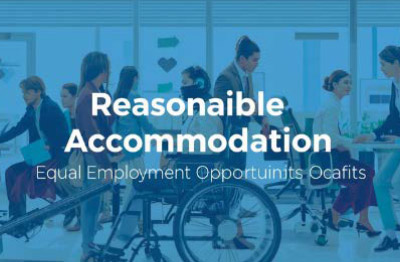Navigating California’s Reasonable Accommodation Laws
Posted on October 1, 2025

Workplace accommodations can feel like a complex puzzle for both employers and employees. In California, the laws are particularly robust, designed to protect workers and ensure they have the support needed to perform their jobs. Understanding these rules isn’t just about compliance; it’s about fostering an inclusive and productive environment.
This post will guide you through the essentials of California’s reasonable accommodation laws. We will explore what engaging in the “good faith interactive process means,” the risks of dismissing unusual requests, and how seemingly neutral company policies can lead to legal trouble.
What is a Reasonable Accommodation?
Under California’s Fair Employment and Housing Act (FEHA), employers with five or more employees must provide reasonable accommodations for employees with known disabilities. A disability can be physical or mental, and the accommodation is any change in the work environment or in how things are customarily done that enables an individual with a disability to enjoy equal employment opportunities.
This could include things like:
- Modifying work schedules
- Providing ergonomic equipment
- Restructuring job duties
- Allowing a leave of absence
- Reassigning to a vacant position
The accommodation must be “reasonable” and not cause an “undue hardship” on the employer. Undue hardship means an action requiring significant difficulty or expense.
The Good Faith Interactive Process: A Two-Way Street
The cornerstone of California’s accommodation law is the “good faith interactive process.” This is a legal requirement for employers to engage in a timely, good-faith dialogue with an employee who requests an accommodation. The goal is to work together to identify an adequate accommodation.
This isn’t just a single conversation. It’s an ongoing effort that requires both parties to participate openly and honestly.
Employer Responsibilities:
- Acknowledge the request: Respond promptly when an employee indicates they need an accommodation. The request doesn’t need to be in writing or use legal terms.
- Gather information: If the disability or need for accommodation isn’t obvious, you can ask for reasonable medical documentation to confirm the existence of the disability and the need for accommodation.
- Explore solutions: Actively discuss potential accommodations with the employee. Be creative and flexible.
- Implement the accommodation: Once a reasonable accommodation is agreed upon, implement it promptly.
Employee Responsibilities:
- Communicate your needs: Inform your employer about your disability and the specific job-related limitations you are experiencing.
- Provide necessary information: Cooperate by providing reasonable medical documentation if requested.
- Be open to alternatives: The employer doesn’t have to provide the exact accommodation you request, as long as the one they offer is effective. Be willing to discuss different options.
Failing to engage in this process can lead to significant legal consequences for an employer, even if no viable accommodation ultimately existed. The focus is on the effort and the dialogue.
The Danger of Dismissing Novel Requests
Sometimes, an employee’s accommodation request might seem unusual or outside the norm. An employer’s immediate reaction might be to deny it. However, dismissing a request without proper consideration is a major pitfall. California law requires employers to consider any requested accommodations.
Real-World Example: Thinking Outside the Box
Consider an employee with severe anxiety triggered by a noisy, open-plan office. They request to bring their small, well-behaved emotional support dog to work. The company has a strict “no pets” policy.
An employer immediately denying the request based on the policy is at high risk. The correct approach is to engage in the interactive process. The employer should discuss the request with the employee. Can the dog be kept in a specific area? Would a trial period work? Are there alternative accommodations that could be equally effective, such as moving the employee to a quiet corner or providing noise-canceling headphones?
The key is to explore the request’s feasibility, not dismiss it outright. An accommodation’s “reasonableness” depends on the specific facts of the situation, not on what is typical or conventional.
How Unlawful Internal Policies Create Risk
Company policies are meant to create consistency and fairness, but they can sometimes be a source of legal liability. A policy that seems neutral on its face may be illegal if it prevents employees from accessing reasonable accommodations.
The Problem with Inflexible Policies
One of the most common issues is a rigid leave of absence policy. For example, a company might have a policy stating that any employee out of work for more than 12 weeks will be automatically terminated.
This type of inflexible policy is unlawful in California. A leave of absence can be a form of reasonable accommodation. If an employee’s doctor indicates they need 14 weeks to recover from a surgery, those additional two weeks of unpaid leave could be a reasonable accommodation that the employer must provide, unless it causes an undue hardship.
By automatically terminating the employee after 12 weeks, the employer has failed to engage in the interactive process and has denied a potentially reasonable accommodation.
Practical Advice for Employers:
- Review your policies: Audit your employee handbook and internal policies. Look for rigid rules related to attendance, leave, and job duties that might interfere with your duty to accommodate.
- Train your managers: Supervisors are often the first point of contact for accommodation requests. Ensure they understand their legal obligation to listen, report requests to HR, and participate in the interactive process.
- Focus on flexibility: Build flexibility into your procedures. Instead of “automatic termination” policies, create a process for evaluating extended leave requests on a case-by-case basis.
Practical Advice for Employees:
- Know your rights: Company policy does not override state law. You have a right to request an accommodation even if it conflicts with a written rule.
- Document everything: Record your accommodation request, conversations with your manager and HR, and any medical documentation you provide.
- Put it in writing: While not required, following up a verbal request with a written one (even a simple email) creates a clear record and helps avoid misunderstandings.
Fostering a Culture of Accommodation
Navigating California’s reasonable accommodation laws requires diligence, communication, and a genuine commitment to supporting your employees. By embracing the good-faith interactive process, considering all requests with an open mind, and ensuring your policies are flexible, you can build a workplace that is not only compliant but also inclusive and supportive.
Understanding your rights empowers employees to advocate for the tools they need to succeed. Open communication is the bridge that connects employees’ needs with employers’ legal duties, leading to solutions that work for everyone.
Questions: Contact EQHR Solutions for Guidance
For expert assistance, contact EQHR Solutions at 855-461-8808. www.eqhrsolutions.com

 Handling Employee Investigations
Handling Employee Investigations Navigating California's AB5: A Guide to Worker Classification
Navigating California's AB5: A Guide to Worker Classification Employee Terminations in California
Employee Terminations in California







